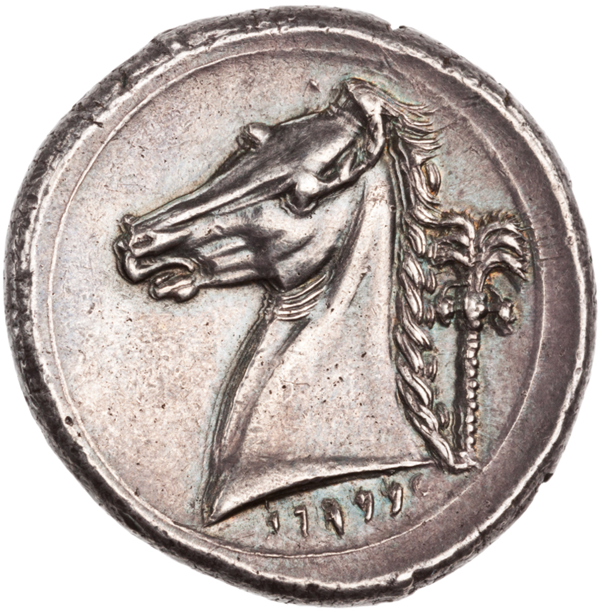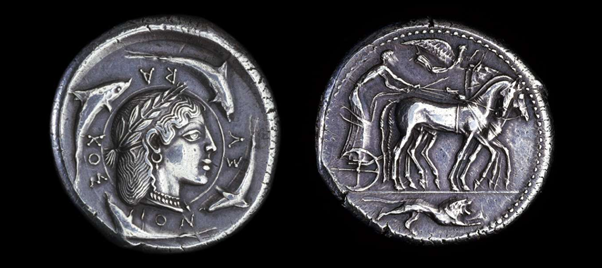
Ancient Coin of the Day: Heading east today, to take a quick gander at some of the gorgeous coins produced by the Arcasids of Parthia, starting with this silver drachm of Arcases I, ca. 220-215 BC. #ACOTD #Parthia #Arcasid
Image: ANS 1991.65.1. Link - numismatics.org/collection/199…

Image: ANS 1991.65.1. Link - numismatics.org/collection/199…


The Arsacids were the ruling dynasty of Parthia from the mid-3rd Century BC until AD 224, taking their name from their founder Arsaces, who conquered Parthia ca. 238 BC, following its secession from the Seleucid kingdom.
Although autonomous coins were rapidly issued by the new dynasty, they necessarily owe much to the existing Seleucid coins, but yet were keen to communicate an idiosyncratic identity in order to distinguish the Arcasids.
Thus on the Obverse of this coin, we see the portrait of Arcases facing left, unlike the right-facing portraits on the majority of Hellenistic coins. The king also wears the bashlik – the traditional soft-pointed cap. 

Similarly, on the Reverse, the archer figure now faces right - a posture that will be retained on Arsacid issues throughout the dynasty, but one which yet again drew a distinction with the archer figure on the earlier Seleucid coins. 

The coins of Mithradates I, who ruled 171-138 BC, see a development of these numismatic tropes, particularly on the Reverse, where the archer figure is seen to be seated on an omphalos.
Image: ANS 1944.100.82014. Link - numismatics.org/collection/194…

Image: ANS 1944.100.82014. Link - numismatics.org/collection/194…


This would seem to be a deliberate adaptation of the Seleucid Reverse, where the figure of Apollo was likewise seated on the omphalos.
Image: Coin of Antiochus I Soter: ANS 1967.152.671. Link – numismatics.org/collection/196…

Image: Coin of Antiochus I Soter: ANS 1967.152.671. Link – numismatics.org/collection/196…


But the Reverse of Mithradates’ coin also shows a development of the Legend as the title ‘Great King’ now features - ΑΡΣΑΚΟΥ ΒΑΣΙΛΕΩΣ ΜΕΓΑΛΟΥ – though still with the dynastic name of Arcases. 

Subsequent tinkering with the coin designs may be seen under Phraates II (138-127 BC), whose coins I rather admire. Note the diademed right-facing portrait, which is more stereotypically Hellenistic.
Image: ANS 1967.152.703. Link - numismatics.org/collection/196…

Image: ANS 1967.152.703. Link - numismatics.org/collection/196…


The Reverse here demonstrates further experimentation, not least with the depiction of a Tyche figure, but one with a bearded male head (perhaps indicating a fusion of the Seleucid ‘Agathos Daimon’/’Tyche’ pairing (?)). 

But the Arcasid coinage perhaps peaks under Mithradates II (121-91 BC), whose coins – like this fabulous silver drachm – by the latter part of his show a portrait resplendent in a royal tiara.
Image: ANS 1944.100.82449. Link - numismatics.org/collection/194…

Image: ANS 1944.100.82449. Link - numismatics.org/collection/194…


The Reverse Legend here also steps things up a notch: ΒΑΣΙΛΕΩΣ ΒΑΣΙΛΕΩΝ ΜΕΓΑΛΟΥ ΕΠΙΦΑΝΟΥΣ - 'Great King of Kings, [God] Manifest' – the Greek being retained, although the legibility of the script is not what it was. 

The departure from the Hellenistic models would continue in the ensuing years, including the period known as the Parthian 'Dark Age', where various figures competed for the throne.
For more on the Parthian ‘Dark Age’, see:
Simonetta, Alberto M. “A Proposed Revision of the Attributions of the Parthian Coins Struck during the So-Called 'Dark Age' and Its Historical Significance.” East and West, vol. 51, no. 1/2, 2001, pp. 69–108.
jstor.org/stable/29757495
Simonetta, Alberto M. “A Proposed Revision of the Attributions of the Parthian Coins Struck during the So-Called 'Dark Age' and Its Historical Significance.” East and West, vol. 51, no. 1/2, 2001, pp. 69–108.
jstor.org/stable/29757495
For more on later Parthian coins, see:
DILMAGHANI, J. “Parthian Coins from Mithradates II to Orodes II.” The Numismatic Chronicle (1966-), vol. 146, 1986, pp. 216–224.
jstor.org/stable/42667464
#ACOTD #Parthia #Arcasid
DILMAGHANI, J. “Parthian Coins from Mithradates II to Orodes II.” The Numismatic Chronicle (1966-), vol. 146, 1986, pp. 216–224.
jstor.org/stable/42667464
#ACOTD #Parthia #Arcasid
• • •
Missing some Tweet in this thread? You can try to
force a refresh
















